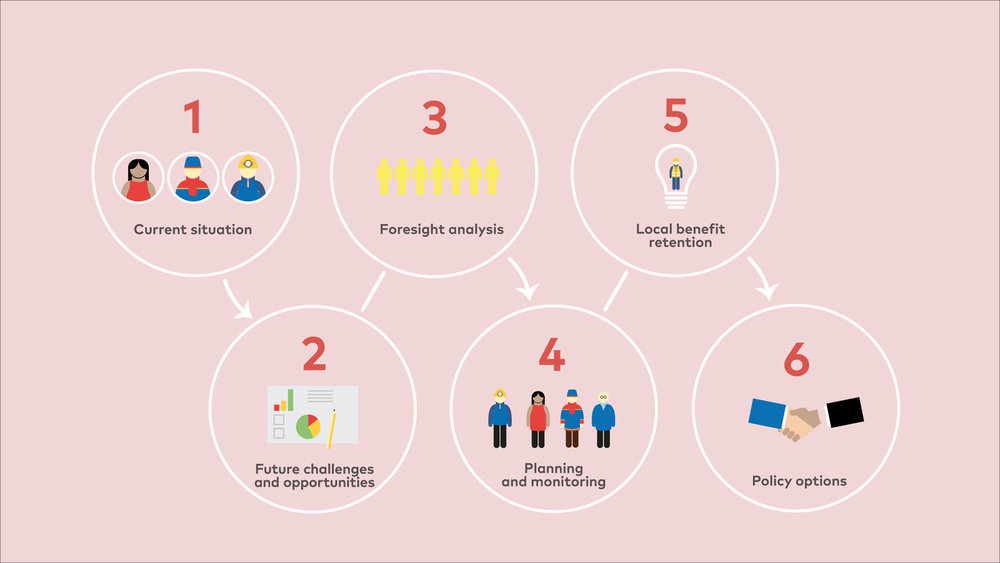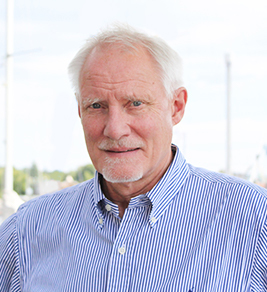REGINA – Regional Innovation in the Nordic Arctic and Scotland with a special focus on regions with large-scale projects
The REGINA project has developed a series of tools and an overall analytic framework to reduce the vulnerability and increase the preparedness of small communities in remote areas of the Nordic Arctic and Scotland facing the development – or closing-down – of large-scale, resource-based industries. The results and the tools developed are also relevant in similar communities elsewhere. The project was part of the Northern Periphery and Arctic Programme 2014-2020 and was finalized in September 2018.
REGINA proposes an innovative framework to develop Local Smart Specialisation Strategies (LS3) for small, remote communities with large-scale, resource-based industrial development. Such LS3s will support local authorities in their efforts to maximize the benefits and minimize the vulnerabilities caused by industrial development.
The REGINA project group consisted of a transnational mix of research institutions, stakeholder groups and five small, remote municipalities. Together they have created LS3s based on the 6-step LS3 model, including three specific planning tools: a Demographic Foresight Model (DFM), a Social Impact Management Plan (SIMP) and a Local Benefits Analysis Toolbox (LBAT).
The 6-step LS3 framework is centred on three common territorial challenges in the Northern Periphery and Arctic area:
1. Demographic Changes: Where an ageing population naturally reduces the reproductive capacity of an area, this is exasperated further by the long-established and selective out-migration of a disproportionate number of young, well-educated persons, especially women. Modern, high-technology resource extraction and processing activities may face challenges in recruiting a local workforce and often resort to regular “fly-in fly-out” solutions, which leak economic benefits out of the local area. This is addressed by the Demographic Foresight Modelling as a strategic planning tool for local authorities.
2. Potential land use conflicts and their social impacts: a key challenge is the ability to ensure a continuous focus on landscape preservation throughout large-scale industrial projects. This includes the wide-ranging social, cultural and economic activities in which local individuals and communities depend on an undisturbed, natural landscape. It also includes the recovery and restoration of the landscape and its cultural aspects after industrial activities cease. The SIMP addresses this: Managing social impacts of resource-based industries in sparsely populated regions (SIMP)
3. Managing green growth potential, including the local retention of benefits: whereby two key conditions are emphasized. First, where the potentials associated with the diverse relationships between economy and ecology are addressed in the planning process. Second, the need to limit export leakage of direct profits, supply chain revenues as well as indirect economic benefits associated with local spending. A special focus will be put on strategies to strengthen the local supply chain linkages of resource-based industries. The Local Benefit Analysis Toolbox – a strategic planning tool for local authorities addresses this.
Local and global relevance
The Local Smart Specialisation Strategies were developed to build upon the existing territorial assets of each community involved – environmental, economic, human or social – to secure the most economically beneficial, socially inclusive and environmentally responsible development.
REGINA has thus tried to respond to the critical challenge of ensuring that sustainable and resilient local community development is prioritised when planning large-scale industrial developments in Europe’s Northern Periphery and Arctic Region.
Overall, REGINA has worked towards improving the preparedness for large-scale investments in small communities and reducing the vulnerabilities of these communities towards the decline or closing down of large-scale projects.
Furthermore, REGINA has aimed to enhance the likelihood of successful outcomes by using transnational cooperation and learning to mobilize local communities in promoting local economic growth and welfare. In this respect, the REGINA results are applicable worldwide in similar resource-based communities in sparsely populated areas as the ones participating in the project.
The 7-step LS3 model is centred on three common territorial challenges in the Northern Periphery and Arctic area (see reverse page). When created, each LS3 will also build upon the existing territorial assets of each community (environmental, economic, human, social etc.), to secure the most economically beneficial, socially inclusive and environmentally responsible future development.
Eventually, the LS3s will be tested and implemented by each of the five municipalities in the project group. Still, REGINA will also create guidance and support tools for other municipalities facing similar types of development challenges.
- REGINA will respond to the critical challenge of ensuring that sustainable and resilient local community development is prioritised when planning the development of large-scale industrial developments in Europe’s Northern Periphery and Arctic Region.
- REGINA will improve the preparedness for large-scale investments in small communities and reduce these communities’ vulnerabilities towards the decline or closing down of large-scale projects.
- REGINA will enhance the likelihood of successful outcomes by using transnational cooperation and learning to mobilize local communities in promoting local economic growth and welfare.
Three common territorial challenges tackled by REGINA:
- Demographic Changes: Where an ageing population naturally reduces the reproductive capacity of an area, this is exasperated further by the long-established and selective out-migration of a disproportionate number of young, well-educated persons, especially women. Modern, high-technology resource extraction and processing activities may face challenges in recruiting a local workforce and often resort to regular “fly-in fly-out” solutions, which leak economic benefits out of the local area.
- Potential land use conflicts and their social impacts: with a key challenge being the ability to ensure a continuous focus on landscape preservation throughout large-scale industrial projects. This includes the wide-ranging social, cultural and economic activities in which local individuals and communities depend on an undisturbed, natural landscape. It also includes the recovery and restoration of the landscape and its cultural aspects after industrial activities cease.
- Managing green growth potential, including the local retention of benefits: whereby two key conditions are emphasized. First, where the potentials associated with the diverse relationships between economy and ecology are addressed in the planning process. Second, the need to limit export leakage of direct profits, supply chain revenues as well as indirect economic benefits associated with local spending. A particular focus will be put on strategies to strengthen the local supply chain linkages of resource-based industries.
All REGINA publications and tools in one place

REGINA has developed the concept of Local Smart Specialisation (LS3) as a support framework for rural and remote communities. It can be used to facilitate strategic decisions when facing the development or the demise of large-scale resource-based industries. This section features the necessary documents to develop your LS3 strategy.
Reader guide: Start with general fact sheets, move on to other primary materials, and finally to additional working material if needed.
The Local Smart Specialisation Framework
The documents here provide an overview of the 6-step LS3 framework, as well as guidelines for mapping your current situation (step 1), assessing challenges and opportunities (step 2) and developing policy options (step 6).
(The main output of the REGINA project focuses on steps 3, 4 and 5 as outlined in the overviews below.)
Factsheet: Empowering remote communities with resource-based economies
Policy Brief: Local Smart Specialisation
Additional working material
The 6-step Model for Local Smart Specialisation Strategies
Step 1 and 2: Summary of local partner workshops
Foresight Analysis (step 3)
This includes guidelines and a template for the REGINA Demographic Foresight Model – DFM.
Factsheet: Demographic Foresight Model (DFM)
User Manual: Demographic Foresight Model
Demographic Foresight Model: Excel Template
Additional working material
Report: Demographic change and labour market challenges
Planning and Monitoring (step 4)
This includes the guidelines to the REGINA Social Impact Management Planning Toolbox – SIMP.
Factsheet: Social Impact Management Tool (SIMP)
User Manual: Social Impact Management Planning Tool
Social Impact Management Plan for Sodankylä (English)
Additional working material
Tools for Monitoring Social impacts of Large-Scale Industries
Report: Local land use planning: Guidance on spatial data
Social Impacts of Mining in Sodankylä
Step 4: Summary of planning and development in REGINA partner municipalities
Local Benefit Retention (step 5)
This includes the guidelines to the REGINA Local Benefit Analysis Toolbox – LBAT.
Factsheet: Local Benefit Analysis Toolbox (LBAT)
Local Benefit Analysis Toolbox: Guidelines for Implementation
Additional working material
Business and Entrepreneurship: Baseline Capacity Reports
Factsheets:
The Local Benefit Analysis Toolbox – a strategic planning tool for local authorities
Managing social impacts of resource-based industries in sparsely populated regions (SIMP)
Demographic Foresight Modelling as a strategic planning tool for local authorities
Empowering remote communities with resource-based economies
Related Staff
Related Publications
- REGINA Policy brief 2017:1: Local Smart Specialisation: a strategy for remote communities with large-scale resource-based industries
- Local land use planning: Guidance on spatial data, geographic information systems and foresight in the Arctic
- Local smart specialisation: a step-by-step guide to social impact management in remote communities with resource-based economies
- Nordregio News 4 2015
- Nordregio News Issue 5 2012: Smart Specialisation for All Regions?
Related News
- REGINA partners meet in Sandnessjøen August 15-17
- 22-24 March: 3rd REGINA partner meeting
- Social impacts of mining – new results from the REGINA project
- Nordregio presented at OECD meeting on mining regions and cities
- Arctic changes and challenges – new issue of Nordregio Magazine
- Launch of new local smart specialisation platform for sparsely populated areas
- “Discovering the Arctic future – as a part of Europe”
- Managing social impact – new guide to making the most of human capital in local communities
- EU project on local development visits Qaqortoq
- 14 June, Nordregio joins the 8th Annual Forum of the EU Strategy for the Baltic Sea Region, Berlin
- Local smart specialisation: Why is it useful?
- Implementing Smart Specialisation in Sparsely Populated Areas








